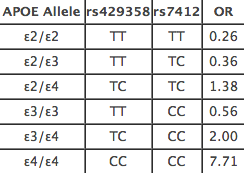
Overview– Some diseases are extremely unpredictable, random, complicated or under-studied which makes it impossible to let you calculate your odds. Luckily, Alzheimer’s Disease isn’t one of them. The most common form of dementia is Alzheimer’s Disease (AD), a chronic neurodegenerative and fatal disease that is characterized by a decline in memory, language and cognitive skills that degrade over time. People with AD eventually lose response to their environment, and develop complete dependence on a caregiver. Knowing risk factors for this disease and calculating your own risk factor and making life-style adjustments can dramatically lower your chances of getting this disease in old age.
The General Odds of Developing Alzheimer’s Disease
Alzheimer’s is a relatively common disease of old age: roughly 1 in 3 seniors will die from this disease and the average person’s lifetime risk is estimated to be around 10-12%. AD is caused by a mixture of genetic, life-style, and environmental factors, with genetics factoring in at around 50-80%. This means if one or both of your parents or grandparents has Alzheimer’s, your odds increase several fold, and you and your siblings have a 50-50 chance of getting AD.
The Most Influential Gene APOE
AD is a complex, multifactorial disease and multiple genes are at play before this disease develops. However, the most well known and influential genetic risk factor for AD is having one or both copies of the e4 variant in the APOE gene. We all have the APOE gene but we have a combination of different allele possibilities (e2, e3, e4). Depending on the combination of our alleles, we are either genetically predisposed to the disease, or protected from it.
Up to 80% of people with Alzheimer’s possess at least one copy of the APOE e4 variant.If you have one or more e4 variant, then you are at a genetically increased risk for developing Alzheimer’s by the time you are 65. If you have both copies, then you are at a 7 times increased lifetime risk for the disease.
However, other risk factors such as family history, environment, and health conditions alter your overall risk. Although you can’t change risk factors such as age and genetics, you can significantly reduce your risks through your diet, lifestyle and environment.
Calculating Your Odds
Your odds ratio varies depending on which allele variant you have in the APOE gene. The average person’s risk for getting AD is around 12% and we’re going to say 1.0 is the averaged, general odds ratio for everyone in the population. Without knowing any genetic or environmental risk odd ratio, we say everyone’s risk is at 1.0
This chart below shows the different odds ratio for different alleles of the APOE gene. You can get your APOE genotype if you have done whole genome sequencing or used a genotyping service like 23andMe or DeCodeMe. Simply look up the rs ID number and identify your genotype.

If your odds ratio is 0.23 it means compared with the average, 1.0 , you have a very low chance of getting Alzheimer’s. Likewise, if your odds ratio is 7.0 it means you are 7 times more likely than the average person, 1.0 , to get Alzheimer’s before the age of 65.
Environmental Factors Count Too
Environmental factors substantially influence overall predicted odds ratio. Even if your genetic odds are low, you can still have an overall high chance if you reinforce habits that is associated with a high risk for Alzheimer’s.
The most influential environmental factors associated with AD:
- Smoking
- Drinking Alcohol
- Education level
Heat injury/Head trauma (applies only to individuals with one or more copies of the e4 variant).
What can you do after knowing your risk factors?
➣ Get tested and know the symptoms Early detection and awareness is key to preventing or slowing the disease. Click here for list of symptoms.
➣Prevent Head Trauma There is strong evidence of a correlation between head injury and future risk of dementia and Alzheimer’s disease. Especially repeated head trauma or concussions for contact sports and accidents puts you at an increased risk. Avoid playing rough sports such as football or boxing and always make sure to buckle your seatbelt in a vehicle. A significant head injury increases a person’s risk with 2 copies of the e4 gene by 1000%.
➣Exercise regularly Research shows that regular physical activity (at least 4 times a week) protects the brain from dementia and also improves symptoms if you already have the disease. Recent studies show that exercise can reduce your overall risk by as much as 30%.
➣Keep learning Staying in school longer or using your brain more is proven to reduce your overall risk. If it isn’t possible for you to stay in school or go back to school, keep your mind active by taking up a new language or hobby.
➣Take care of your heart There is a definitive link between heart health and brain health. Heart disease, high blood pressure and high cholesterol can raise the risk of getting AD.

